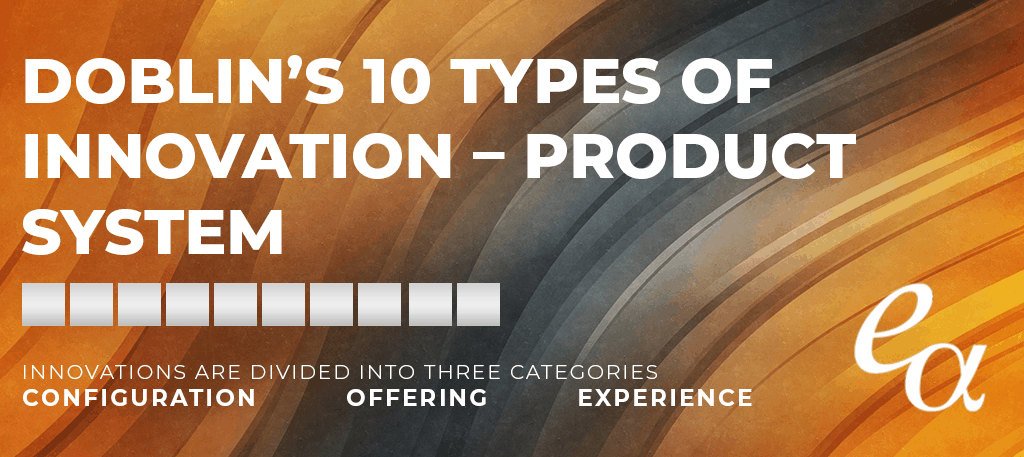Intro
In this series of posts, we will be inspecting Doblin’s 10 Types of Innovation, a popular framework for analyzing innovations in business developed by the Doblin Innovation Firm in Chicago. Innovations are divided into three categories: configuration, offering, and experience. Configuration focuses on the innermost workings of an enterprise and its business system, offering focuses on an enterprise’s core product or service, and experience focuses on customer-facing elements. In this post, we will analyze the second block in offering, product system innovation.
Definition
Product System Innovation is essentially about how you create complementary products and services. Doblin defines product system innovation as:
“Product System innovations are rooted in how individual products and services connect or bundle together to create a robust and scalable system. This is fostered through interoperability, modularity, integration, and other ways of creating valuable connections between otherwise distinct and disparate offerings. Product System innovations help you build ecosystems that captivate and delight customers and defend against competitors.”
Product system innovations all revolve around the complementary system around a company’s main product offering. This can also include offerings that the company doesn’t own or produce but create additional value when added into the system. Thus, it isn’t always necessary for a company to produce all components of a system. Similar to process innovation, product system innovations address and implement a venture’s core value proposition.
Examples
In the 21st century, some of the most common product systems are platforms created by technology companies that encourage others to develop products and services for them, including app stores, developer kits, and APIs. That being said, here are some of the most common types of product system innovations.
- Bundling – taking several related products and selling them in a single package
- Complements – Products that individually work fine on their own, but increase in functionality when used together
- Modular systems – Products that take advantage of customization and many interchangeable parts
- Extensions – new products (including those from other manufacturers) that “go with” or “plug in” to existing products
- Product/Service Platforms – products and services that work in conjunction with one another
For this blog post, we will focus on examples regarding bundling, complements, modular systems, and extensions.
Bundling
These products combine several related products and sell them as a single package, usually at a lower cost than if one were to purchase all the products separately.
Microsoft is an American multinational technology company that develops and sells computer software, consumer electronics, personal computers, and related services. Microsoft’s productivity applications, including Word, PowerPoint, and Excel, were initially sold as separate products until they were bundled together in the Microsoft Office suite in the late 1980s. As a result of their cross-compatibility and unified support and services, it is now exceedingly rare to find users who only purchase one of the applications — more often than not, users own the whole suite.
Oscar Mayer is an American meat and cold cut production company owned by Kraft Heinz. Their Lunchables product are kid-friendly lunch packages that contain crackers, meat, cheese, desserts, and drinks, products that Oscar Mayer also offers individually. The result is increased sales across all brands for Oscar Mayer and an easy option for busy parents.
M-Pesa is a mobile phone-based money transfer, payments and micro-financing service launched in 2007 by Vodafone Group and Safaricom in Africa. While a singular service, M-Pesa provides multiple offerings at once, including tens of thousands of M-Pesa shops and additional branchless banking facilities to give customers a one-stop shop and ecosystem for all their financial needs. The result is a smooth end to end customer experience and customers who have no need to look outside of M-Pesa.
Complements
These product systems have products that work individually but have extra value when used together.
Apple is an American multinational technology company that designs, develops, and sells consumer electronics, computer software, and online services. Apple is famous for their closed product system, providing unparalleled integration, connectivity, and a seamless user experience between their various products. With the individual popularity of each product, Apple is able to bring more customers into its ecosystem, and has reaped the benefits — it is now one of the most valuable companies in the world.
Gillette is an American brand of safety razors and other personal care products including shaving supplies owned by Proctor & Gamble. They have two product systems for men and women (the latter under the brand name Gillette Venus) and both systems have razors and complementary products like disposable blades, shaving gel, blade refills, and more. By including complementary products in their product system, Gillette gives customers the option of being a one stop shop should they so desire.
Modular Systems
These product systems can incorporate many interchangeable parts with a focus on customization.
Scion is a now-discontinued marque of Toyota that manufactured inexpensive but stylish sport compact vehicles aimed at younger customers. Because their key demographic preferred customization and choice in their purchases, Scion allowed buyers to select from a number of options for nearly every aspect of the car, from base model and paint color to type of lights, special engines, and audio configurations. Each add-on added value to the greater product system of Scion and Toyota, and thus allowed for higher margins.
IFTTT, which stands for If This Then That, is a service that allows users to connect different apps and devices to each other so that they can be used as triggers in order to program a response to real-world events — for instance, a user could program their smart thermostat to turn on heating if the temperature falls below a certain level. IFTTT is an open product system at the core of “the Internet of things,” allowing for many different interchangeable devices that can be combined with triggers and actions in order to form the executable “recipes.” IFTTT revolutionized the way we approached “smart” tech, and is now the connecting logic hub for devices from hundreds of companies like Apple, Amazon, Google, and Samsung.
Extensions
These product systems incorporate new, companion products (not necessarily from the same company) that work in conjunction with existing products.
Nike is an American multinational corporation that designs and manufacturers footwear, apparel, equipment, accessories, and services. They were one of the first companies to develop apps and technology to integrate into their footwear through Nike+, which incorporated an activity tracker device into the shoe itself. With these extension products, Nike was able to further solidify their fitness and sport lifestyle brand, build brand loyalty, and create a stronger product system.
Airbnb is an online marketplace for lodging, primarily homestays for vacation rentals and tourism. Airbnb recently expanded into offering complementary services to people visiting new places through Experiences, which offers experiences like cooking, animal interactions, and nature excursions sold by local guides. As a result, Airbnb was able to expand their revenue stream and let customers know that they’re more than just an accommodations website.
Mozilla is a non-profit organization that exists to support and lead the open source Firefox web browser project. Because the browser is open source, independent developers are able to create countless plug-ins and extensions to enrich the product. Firefox has been lauded as a great model for an open product system and decentralized innovation, and has hundreds of millions of users worldwide.
Techniques to Develop Product System Innovation
There are two ways to develop product system innovation. The first is to develop and create a product system around your main product. This consists of building your own benefit ecosystem that customers will love and that is difficult for competitors to copy. One can do this by creating new products the way Gillette created shaving accessories to accompany their razors, or by working with suppliers and other companies to provide the complementary products, like the way Apple works with outside developers through the App Store to build programs for their products.
The second is to develop and create products that can be integrated into the product system of a main product belonging to another company. In this situation, a company would be the outside developer or supplier providing the complementary good. This strategy has lower competitive advantages, as your products and therefore profits are dependent on the success of a system that isn’t yours, but it is nonetheless a suitable business model, especially among smaller companies. While competition might be fiercer, the risks are usually outweighed by the sheer number of users that can be accessed through a larger product system.
The core questions, regardless of which position a company is in, remain the same. Regarding the main product or service, what can you do to improve it? Could you or a partner create additional related, modular, or peripheral products? What complementary offers can you add to it to satisfy customers’ needs better, and thus capture more profit? Ultimately, all product system innovation revolves around determining the relationship between technology development and product development at a company followed by the matching of that relationship to customer needs.
Impact
Product system innovations are mutually beneficial for customers as well as companies. Customers benefit from the added benefits, better user experience, increased convenience, and usually, the cheaper costs. For companies, product system innovations have a unique way of retaining customers over time, creating a deep connection with the user and getting them invested in your ecosystem, thus making it more difficult for them to leave. These product and service ecosystems make customers believe that they need additional components or complements to further enrich the experience of an offering they’re already enjoying.
Product system innovations also have larger industry or market-wide implications. Because more and more companies are creating product systems, they risk developing similar complements to products that are already nearly identical in the first place. As a result, these product systems are in danger of becoming fundamentally substitutes of each other. If companies are incapable of distinguishing their products and the added value of their ecosystems from those of their competitors, all players in a market may fail to secure an effective product system and thus suffer huge losses by failing to recoup their investments in new complementary products.
Conclusion
Product system innovations have the potential to lock out competitors, increase profits, and secure long-term customers who enjoy the benefits of integrated ecosystems. Though not every company has a product system, most companies are in a product system — these days, fully stand-alone products and services are rare, in technology especially. Just think about the technology that we use every day — all enterprise software used by businesses works seamlessly together, nearly every application on a smartphone is built by a different developer, and headphones, cars, and fitness trackers all speak a common language called Bluetooth. As our world becomes more connected and integrated, product systems, both open and closed, will be the path to a smarter, more convenient future.




